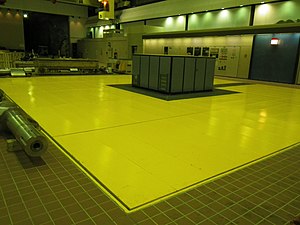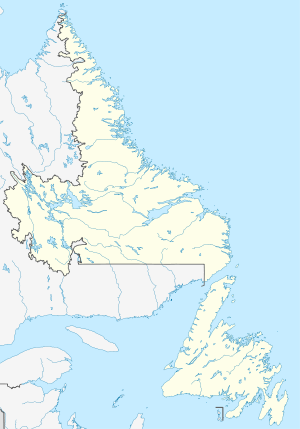Churchill Falls hydroelectric power station
| Churchill Falls hydroelectric power station | |||
|---|---|---|---|
| Turbine at Churchill Falls hydroelectric power station | |||
| location | |||
|
|
|||
| Coordinates | 53 ° 36 '0 " N , 64 ° 18' 57" W | ||
| country | Canada | ||
| Waters | Churchill River ( Smallwood Reservoir ) | ||
| Data | |||
| Type | Run-of-river power plant | ||
| Primary energy | Hydropower | ||
| power | 5428 MW | ||
| owner | Churchill Falls (Labrador) Corporation Limited | ||
| operator | Newfoundland and Labrador Hydro | ||
| Project start | 1967 | ||
| Start of operations | 1971-1974 | ||
The Churchill Falls hydropower plant is an underground run-of-river power plant in the Canadian province of Newfoundland and Labrador . Located on the Churchill River in the Labrador region near the 75-foot-high Churchill Falls , it is propelled by water from the 6,527 km² Smallwood Reservoir . The power plant generates an output of 5428 megawatts . Construction began in 1967 and commissioning took place gradually between 1971 and 1974. The owner is Churchill Falls (Labrador) Corporation Limited, in which Nalcor Energy has a 65.8% stake and Hydro-Québec has a 34.2% stake. It is operated by Newfoundland and Labrador Hydro , a subsidiary of Nalcor Energy.
history
Planning
The Québec Province Aquatic Commission , which claimed Labrador, dispatched engineer Wilfred Thibaudeau to survey the Labrador Plateau in 1915. Thibaudeau was impressed with the area's hydropower potential and designed a canal system that could have diverted the water before it reached the waterfall. This would eliminate the need to build massive dams. With an award from the Justice Committee of the British Privy Council , the Dominion Newfoundland gained sovereignty over the disputed area.
In 1949 Newfoundland became a Canadian province. Joey Smallwood , the Newfoundland Prime Minister, drove a hydropower project in the Churchill River basin. In 1952 the British Prime Minister Winston Churchill put him in contact with various companies, in particular with the financial institution NM Rothschild & Sons . The consortium British Newfoundland Development Corporation (Brinco) was founded in 1953 under the leadership of the Rothschilds . The paper manufacturers Bowater and Anglo-Newfoundland, the industrial company English Electric and the mining companies Rio Tinto , Anglo American and Frobisher were also involved. With the development of iron ore mines in western Labrador and the construction of the Quebec North Shore and Labrador Railway , the construction of the hydroelectric power station at the then named Hamilton Falls had become economical.
Shawinigan Engineering, a subsidiary of the power company Shawinigan Water and Power Company (SW&P), carried out consulting activities for Brinco from 1954. In 1958, SW&P took a 20% stake in the newly founded joint venture Hamilton Falls Power Corporation , investing CAD 2.25 million . Following the customary practice at the time, Brinco tried to find buyers for the electricity to be produced before construction began. But the aluminum groups Alcan , Alcoa and British Aluminum decided against building plants in Labrador and the United Kingdom Atomic Energy Authority decided against building a uranium enrichment plant . The export of electricity to Ontario was also disregarded, as this province preferred to operate nuclear power plants for reasons of cost.
In 1963, the SW&P was nationalized and merged with Hydro-Québec . The state-owned enterprise of the province of Québec also took over the 20 percent share in the hydropower project in Labrador. In 1965, Hamilton Falls was renamed Churchill Falls in honor of the late Winston Churchill.
Construction work
After years of planning work officially began on July 17, 1967. A consortium of two construction companies, the Canadian Acres and the American Bechtel Corporation , was responsible for this . Due to the harsh climatic conditions, the construction work turned out to be very difficult. In addition, the area was inhospitable and far from human settlement. The power house was carved into the hard rock at a depth of up to 300 meters. At the time, this construction site was the largest in North America and employed up to 6,300 workers. The construction cost was $ 946 million.
In order to use the total drop of 316 meters, no large barricades had to be built. It was only necessary to divert the Churchill River with canals and dams. The 88 dams have a total length of 64 km and a maximum height of 36 m. These dam the 6527 km² Smallwood Reservoir, which was named after Joey Smallwood. The power station made its first electricity deliveries on December 6, 1971, five months and three weeks before the originally scheduled time. The last of the eleven turbines went into operation in 1974. As is so often the case, the rights of the indigenous Labrador people, the Innu people , had not been respected and no compensation was paid. The Innu had previously used the area flooded by the reservoir for hunting and trapping.
Litigation
In the provinces of Newfoundland and Labrador, the division of the profits from the electricity produced in the power plant repeatedly caused political controversy. After years of negotiations, Hydro-Québec and Brinco had finally reached an agreement on the financing of the project on May 12, 1969. With the contract, Hydro-Québec committed itself to purchase most of the power plant's production for a quarter of a cent per kilowatt hour (kWh) for 65 years - the exact tariff is 0.25425 cents / kWh up to 2016 and 0.2 cents / kWh for the remaining 25 years of the contract term - as well as part of the interest rate risk and the debts of Brinco. In return, the company received a 34.2% stake in Churchill Falls (Labrador) Corporation Limited.
In 1972, the Liberal Prime Minister Joey Smallwood was replaced by the Conservative Frank Moores . The new government disagreed with the terms of the treaty after the 1973 oil crisis , believing they were too favoring Hydro-Québec. They threatened Brinco with expropriation and finally acquired in June 1974 for 160 million dollars all non-Hydro-Québec shares in the Churchill Falls company. At the same time it took over the water usage rights on the Churchill River. The Newfoundland government insisted on renegotiating the contract, but Hydro-Québec repeatedly refused. After lengthy legal battles between the two neighboring provinces, the Supreme Court of Canada upheld the treaty twice in 1984 and 1988. If Hydro-Québec had to pay market prices for the electricity supplied from Churchill Falls, the profits would be around 75% lower, as the economist Claude Garcia calculated.
investment
Similar to Niagara Falls , the water is diverted to the power station and rarely flows down the waterfall when there is high water. Here an output of 5428 MW is achieved with eleven turbines , and the power plant could be expanded to 6,300 MW. This makes Churchill Falls the second largest in Canada after the Robert Bourassa power plant . The running wheels of the Francis turbine are made of stainless steel and weigh 70 tons each. The power house is located in an underground cavern , which is the second largest in the world. The dimensions of the power house are: 296 m × 25 m × 47 m; the height corresponds to a 15-storey high-rise. For this, 1.9 million m³ of rock were blasted from the granite rock of the Canadian shield . The material was used in the construction of roads and dams. The annual energy production is 35,000 GWh. The electricity is now also conducted to Québec and the USA.
There are currently plans to expand the hydropower facilities on the Churchill River to a total of 9,252 MW.
literature
- Philip Smith: Brinco: The story of Churchill Falls . McClelland and Stewart, Toronto 1979, ISBN 0-7710-8184-7 .
Web links
- Operator website Nalcor Energy
- Churchill Falls Hydroelectric project
- A visit to Churchill Falls hydroelectric power station
- Map of the project area
- Profile of the Innu people of Labrador
- Churchill Falls ( English, French ) In: The Canadian Encyclopedia .
Individual evidence
- ^ A b c André Bolduc: Churchill Falls, the dream ... and the reality . In: Forces . Montreal 1982, p. 40-42 .
- ^ Smith: Brinco: The story of Churchill Falls. Pp. 17-18.
- ^ Smith: Brinco: The story of Churchill Falls. P. 151.
- ↑ About Churchill Falls - history. (No longer available online.) Nalcor Energy, archived from the original on March 21, 2012 ; accessed on March 11, 2012 (English).
- ^ Peter Green: The History of Churchill Falls. IEEE Canada, accessed March 11, 2012 .
- ^ Power Contract Between the Quebec Hydroelectric Commission and the Churchill Falls (Labrador) Corporation. (PDF, 4.32 MB) archive.org, 1969, accessed on March 11, 2012 (French).
- ^ Annual report 2009 Nalcor Energy. (PDF, 3.31 MB) (No longer available online.) Nalcor Energy, 2010, p. 48 , archived from the original on July 14, 2011 ; accessed on March 11, 2012 (English).
- ^ Smith: Brinco: The story of Churchill Falls. P. 372.
- ^ Renvoi relatif à Upper Churchill Water Rights Reversion Act, (1984) 1 RCS 297. Institut canadien d'information juridique, May 3, 1984, accessed on March 11, 2012 (French).
- ^ Hydro-Québec c. Churchill Falls (Labrador) Corp., (1988) 1 RCS 1087. Institut canadien d'information juridique, June 9, 1988, accessed March 11, 2012 (French).
- ^ Privatization d'Hydro-Québec: Claude Garcia s'explique. (No longer available online.) La Presse February 4, 2009, archived from the original April 17, 2009 ; Retrieved March 11, 2012 (French).

